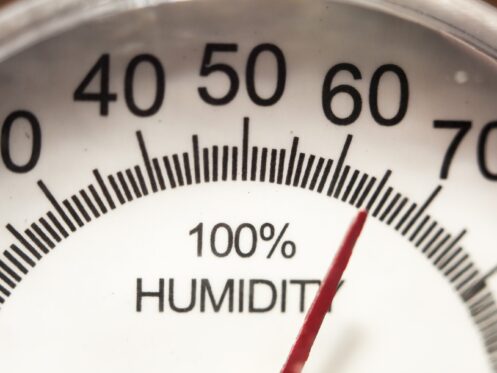While Colorado is a beautiful place known for its clean, fresh air, it’s also a semi-arid climate. This means that its humidity level tends to remain between 25% and 30% all year round. With forced-air heat and AC, indoor humidity levels can plummet. This can be great for the summer months to prevent you from overheating in hot temperatures.
However, it can create real problems during the colder winter months.
Why Humidity Matters for Your Health
You know that heating your home in the winter and cooling it in the summer are necessary to maintain your comfort and general health. However, it’s important to also understand the role that humidity has in your overall comfort and well-being. When indoor humidity levels are below the recommended 30% to 50%, they can cause unfavorable health symptoms.
One of the most obvious is dry skin. Your skin naturally has a moisture barrier that helps to keep it healthy. When humidity levels are low, it can erode the moisture barrier and cause your skin to dry out and flake. The low humidity can dry out your nasal passages, leading to sinus irritation. This can also increase your risk of contracting viruses because a dried-out nasal cavity isn’t as effective at catching those unwanted microorganisms before they reach your sinuses. Dry sinuses can also contribute to snoring, disrupting sleep.
Another rather uncomfortable symptom of low indoor humidity is dry eyes. Low humidity causes your eyes’ natural tears to evaporate instead of lubricating your eyes. One other notable health problem that low humidity can cause is an aggravation of your asthma or allergy symptoms. This is typically the result of unwanted airborne allergens, like dust, more readily circulating in overly dry air.
How Low Humidity Affects Your Home
If it’s not already enough that low humidity affects your health, it’s also important to note that it can affect your home. Any wooden components in your home can experience shrinkage when humidity levels are too low. This can lead to cracking, warping, and permanent damage to those wooden features.
This can include everything from your wooden furniture to your trim and doors. You may even notice that your doors don’t seem to shut right. Low humidity can cause drywall compound to shrink, making gaps more visible, typically between your ceilings and your walls. You’ll notice more static electricity throughout your home, which can be rather annoying to deal with.
Low Humidity Can Lead to Higher Energy Bills
When it comes to your home comfort during the winter season, having a low indoor humidity level can have a negative effect. Low humidity allows any sweat to evaporate on your skin faster, cooling down your body. Furthermore, heat doesn’t remain in the air as long when the humidity level is low as compared to a more desirable relative indoor humidity level.
Even worse, as you heat your home, you’re naturally removing more humidity from your indoor air. Unfortunately, when you feel uncomfortable and cold during the winter, you’ll be more likely to turn up the temperature on your thermostat. This will cause your HVAC system to run more often, driving up your heating bills.
How to Best Control Indoor Humidity
One of the absolute best ways to control indoor humidity in Colorado’s dry climate is with a whole-home humidification system. Many people are familiar with portable humidifiers that you fill with water and plug into your wall outlet to release moisture into the air. While these can be effective for certain spaces in your home, they can’t produce enough humidity to bring your entire home up to a desirable level. They also require daily refilling and frequent cleaning.
This is where a whole-home humidification system comes into play for improving indoor air quality. This is usually installed directly inside the return ducting of your existing HVAC system. It will introduce more moisture into the air to raise the humidity level inside your home. Unlike with portable units, you don’t have to worry about refilling a whole-home humidification system, as it will have a direct line to your water supply.
Your whole-home humidification system will work based on your thermostat’s setting. You may need to upgrade your existing thermostat if it doesn’t have controls for indoor humidity. With the right thermostat, you simply set your desired indoor humidity level. Anytime that your thermostat senses the humidity level is too low, it will signal to your whole-home humidification system to turn on whenever your heating or cooling system is running. It will continue to run until your humidity level reaches your desired setting, and then the humidification system will turn off.
Optimal Indoor Humidity Settings
It’s generally recommended to have your whole-home humidification system set at a humidity level between 30% and 50%. If you set it any lower, you’re likely to experience the negative effects of low humidity, like dry skin and sinus irritation. However, if you set the humidity level too high, it can lead to a slew of other issues, like mold and mildew growth.
We highly suggest starting at a relative indoor humidity level of around 40%. The trick is to find the ideal setting that maximizes your indoor comfort. In winter, as the humidity level rises, your indoor air will retain the heat your heating system produces for longer. This will increase your comfort while reducing the need to constantly turn off the temperature on your thermostat. In summer, the increased humidity is beneficial for your overall health.
Maximizing Your Whole-Home Humidification System’s Performance
While implementing a whole-home humidification system is a great step in helping to better control your relative indoor humidity level during the dry winter months, it’s only effective if your home is well-insulated. If your home has various air leaks on its exterior walls or minimal insulation, that dry outside air can easily seep into your home.
This will cause your humidification system to constantly run to combat that decrease in indoor humidity. We highly recommend taking the time to assess all the exterior walls in your home to identify if you have air leaks. These tend to open up around door frames, window frames, light switches, and outlets.
You should notice a direct change in temperature when you run your hand over the location of the air leak. You can seal up the leak with something like weather stripping, spray foam, or even a foam insert pad that sits behind the cover for your light switch or outlet.
Consulting a Professional
If you’ve noticed the various symptoms of low indoor humidity that we went over above, it’s time to consult one of our professional technicians. We can gladly test your relative indoor humidity level to verify your suspicions and recommend the best whole-home humidification system to boost your air quality level.
Just as HVAC systems require professional installation, so do whole-home humidification systems. This helps ensure proper installation procedures and will keep the warranty coverage on your new system active.
Reliable Whole-Home Humidification Service
Alphalete Plumbing Drain Heating & Air provides reliable whole-home humidification services to the Colorado Springs, CO community. We’re locally owned and family-run. We can also help with all your whole-home air purification, cooling and heating maintenance, and all your other HVAC needs.
Just call our office today to schedule your next consultation with one of our experienced technicians.


